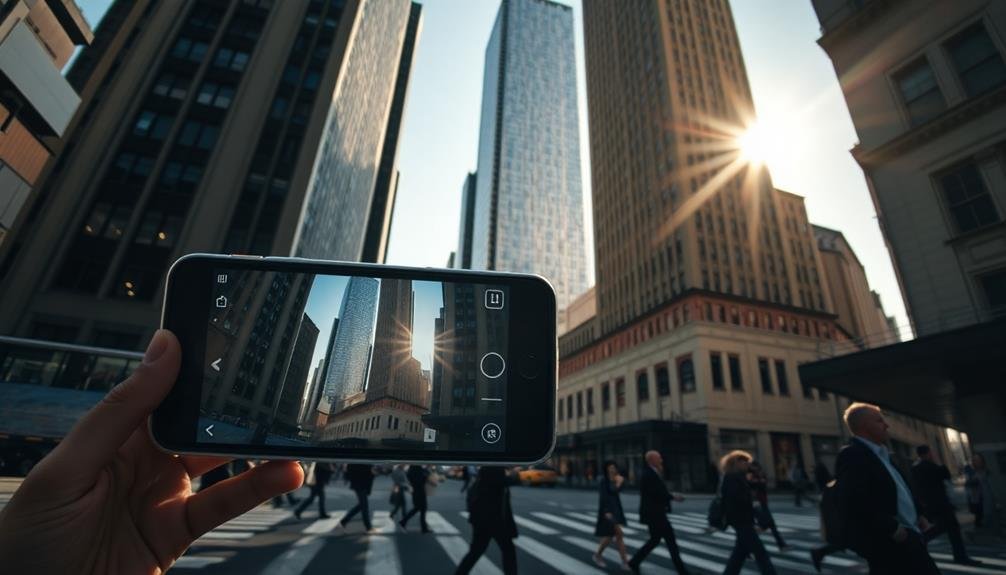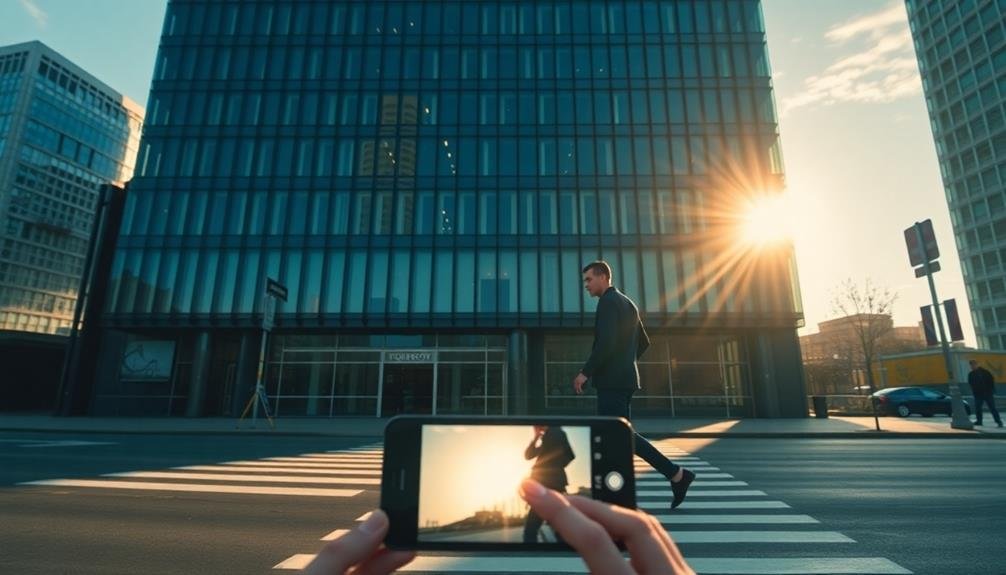Diagonal lines are your secret weapon for creating dynamic mobile photos. They guide the viewer's eye, add movement, and create visual interest. To harness their power, tilt your phone, look for natural diagonals in architecture or landscapes, or create implied diagonals through subject placement. Use the rule of thirds to position key elements along these lines for maximum impact. Experiment with different angles and perspectives to enhance the diagonal effect. Don't forget to use leading lines, contrast, and negative space to complement your diagonal compositions. By mastering these techniques, you'll transform your mobile photography from ordinary to extraordinary. The world of dynamic compositions awaits your exploration.
Understanding Diagonal Line Composition

Diagonals are powerful tools in mobile photography composition. They create a sense of movement and energy, guiding the viewer's eye through the image. When you're framing a shot with your smartphone, look for natural diagonal lines in your environment. These can be found in architecture, landscapes, or even in the way people or objects are positioned.
To effectively use diagonal composition, place your subject along or near a diagonal line. This creates a dynamic balance and draws attention to the main focus of your image. You can also create diagonals by tilting your phone slightly, which adds an interesting perspective to otherwise static scenes.
Experiment with different angles to find the most impactful diagonal. Try shooting from low or high vantage points to emphasize diagonal lines. Remember, diagonals don't have to be perfect or obvious; subtle diagonals can be just as effective in creating visual interest.
Combine diagonal lines with the rule of thirds for even more compelling compositions. Place key elements at the intersection of diagonal lines and third lines to create a harmonious and engaging image that keeps the viewer's eye moving throughout the frame.
Power of Visual Flow

Visual flow is the invisible path that guides a viewer's eye through your photograph. It's a powerful tool that can make or break your mobile photo composition. By understanding and controlling visual flow, you'll create more engaging and impactful images that hold your audience's attention.
To harness the power of visual flow in your mobile photography:
- Use leading lines to direct the eye
- Employ contrast and color to create focal points
- Leverage negative space to balance your composition
When composing your shot, think about where you want the viewer's gaze to travel. Start with a strong entry point, such as a bold foreground element or a striking contrast.
Then, use diagonal lines, curves, or repeating patterns to guide the eye through the frame. Pay attention to how different elements in your scene interact and create movement.
Remember that visual flow doesn't have to be linear. You can create circular or zigzag patterns that encourage the viewer to explore your image multiple times.
Creating Depth and Perspective

You can enhance your mobile photos by creating a sense of depth and perspective.
Try using the converging lines technique to draw the viewer's eye into the image, or leverage vanishing points to create a powerful illusion of distance.
Don't forget to balance your foreground and background elements, as this interplay can greatly boost the three-dimensional feel of your shots.
Converging Lines Technique
The converging lines technique is a powerful tool for creating depth and perspective in mobile photography. When you use this method, you're guiding the viewer's eye through the image along lines that appear to converge at a distant point.
These lines can be natural, like roads or railway tracks, or architectural, such as building edges or bridges. By positioning these converging lines strategically in your frame, you'll create a sense of three-dimensionality and draw attention to your focal point.
To effectively use the converging lines technique:
- Look for strong linear elements in your environment that lead to a vanishing point.
- Position yourself so that these lines start from the corners or edges of your frame.
- Experiment with different angles to find the most dynamic composition.
Vanishing Point Utilization
Building on the converging lines technique, vanishing point utilization takes your mobile photography to the next level. This method creates a powerful sense of depth and perspective in your images, drawing the viewer's eye into the scene.
To use vanishing points effectively, look for scenes with strong linear elements that converge at a single point in the distance. Roads, railway tracks, or long hallways are perfect examples. Position your phone to capture these lines as they appear to meet at the horizon or a distant focal point.
When composing your shot, place the vanishing point off-center using the rule of thirds. This creates a more dynamic and engaging image than centering it. Experiment with different angles and heights to find the most compelling perspective.
Use leading lines to guide the viewer's gaze towards the vanishing point. These can be natural elements like tree lines or man-made structures such as fences or buildings.
Incorporate foreground elements to enhance the sense of depth and scale in your composition.
Foreground-Background Balance
Mobile photography's depth and perspective hinge on mastering foreground-background balance. This technique creates a sense of three-dimensionality in your images, drawing viewers into the scene. To achieve this balance, you'll need to reflect on the relationship between objects in the foreground and the background, ensuring that both elements contribute to the overall composition.
When composing your shot, look for opportunities to include interesting foreground elements that frame or lead into the background. This could be anything from a nearby rock formation to an overhanging branch. These elements add depth and create a more immersive experience for the viewer.
To effectively balance foreground and background in your mobile photos:
- Use the rule of thirds to place key elements at intersecting points.
- Experiment with different angles and perspectives to find the best balance.
- Adjust your focus to emphasize either the foreground or background, depending on your desired effect.
Guiding the Viewer's Eye

You can enhance your mobile photos by skillfully guiding the viewer's eye through the composition.
Creating visual pathways within your image helps lead the viewer's gaze to key elements and adds a sense of flow.
Creating Visual Pathways
Visual pathways serve as silent guides, leading the viewer's eye through your mobile photo composition. By strategically placing elements, you can create a natural flow that enhances the overall impact of your image.
Consider using diagonal lines, curves, or repeating patterns to establish these pathways. They'll help you direct attention to your main subject while adding depth and interest to your photos.
When composing your shot, look for existing lines in the scene that can serve as visual pathways. These might include roads, fences, shorelines, or even the arrangement of people or objects.
Position your camera to emphasize these lines and create a sense of movement within the frame. Don't forget to use leading lines to draw the eye towards your focal point.
To effectively create visual pathways in your mobile photography:
- Identify natural lines in your environment
- Experiment with different angles to emphasize these lines
- Use foreground elements to establish depth and guide the viewer's gaze
Emphasizing Focal Points
Creating a strong focal point is essential in mobile photography. It's the element that draws the viewer's eye and anchors your composition. To emphasize your focal point, use the rule of thirds to place it at one of the intersecting points. This creates a more dynamic and interesting image than centering your subject.
Experiment with contrast to make your focal point stand out. Use differences in color, light, or texture to separate your subject from the background. Leading lines can also guide the viewer's eye to your focal point. Look for natural lines in your environment, like roads, fences, or architectural elements, and position them to point towards your subject.
Consider using depth of field to isolate your focal point. While mobile phones have limitations in this area, you can still create a shallow depth of field effect by getting close to your subject or using portrait mode if available.
Negative space can also be powerful in emphasizing your focal point. By surrounding your subject with empty space, you draw attention to it and create a sense of scale or isolation.
Balancing Dynamic Tension

Tension lies at the heart of compelling mobile photography. When you balance dynamic tension in your shots, you create visual interest that draws viewers in and keeps them engaged. This tension often arises from the interplay of opposing elements within your frame, such as light and shadow, colors, or shapes.
To effectively balance dynamic tension in your mobile photos:
- Use diagonal lines to create a sense of movement and energy.
- Incorporate contrasting elements, like smooth textures against rough surfaces.
- Play with asymmetry while maintaining overall balance in the composition.
As you compose your shot, pay attention to how different elements interact. Look for ways to create visual push and pull within the frame.
You might position a subject off-center, counterbalanced by negative space or a secondary element. Experiment with angles and perspectives to enhance the sense of tension.
Incorporating Natural Diagonals

Incorporating natural diagonals can greatly enhance the dynamism of your mobile photos.
You'll want to keep an eye out for existing diagonal elements in your scenes, such as sloping hillsides, angled buildings, or tilted tree trunks.
If you can't find obvious diagonals, try creating implied ones by strategically positioning your subjects or using leading lines to guide the viewer's eye diagonally across the frame.
Finding Existing Diagonal Elements
Sharp eyes can spot diagonal elements that naturally occur in our surroundings, providing dynamic lines to enhance mobile photo compositions.
As you explore your environment, look for architectural features like staircases, railings, or angled rooflines. Nature offers a wealth of diagonal opportunities, from sloping hillsides to tree branches reaching skyward.
Even in urban settings, you'll find diagonal lines in street signs, lampposts, and shadows cast by buildings.
To incorporate these elements effectively, position yourself to maximize their impact. Move around your subject, adjusting your angle and perspective until the diagonal lines lead the viewer's eye exactly where you want it to go.
Don't be afraid to get low or climb high to capture the most compelling diagonal compositions.
Here are three tips to help you find and use existing diagonal elements:
- Scan the horizon for sloping landscapes or skylines
- Look for intersecting lines that create triangular shapes
- Use reflections in water or glass to create mirrored diagonals
Creating Implied Diagonals
While existing diagonal elements can be powerful compositional tools, you don't always need to rely on obvious lines. You can create implied diagonals through careful arrangement of subjects and objects within your frame. This technique adds dynamic energy to your mobile photos without relying on visible linear elements.
To create implied diagonals, position your main subject off-center and use secondary elements to lead the viewer's eye diagonally across the image. For example, place a person in the lower-left corner and a distant landmark in the upper-right. You can also use a series of objects that gradually decrease in size, creating a diagonal path for the eye to follow.
Color and contrast can help establish implied diagonals. Use bright or contrasting colors to draw attention to specific areas of your image, guiding the viewer's gaze diagonally. Lighting can play a similar role, with highlights and shadows creating a sense of diagonal movement.
Remember that implied diagonals can be subtle. They don't need to dominate the image but should enhance its overall flow and composition. Experiment with different arrangements and elements to find the most effective implied diagonal for your mobile photo.
Architectural Elements as Diagonals

Architectural elements offer a wealth of opportunities for creating dynamic diagonals in your mobile photography. Buildings, bridges, and urban structures often feature strong lines that can lead the viewer's eye through your composition.
Look for staircases, railings, or the edges of skyscrapers to introduce powerful diagonal elements into your shots. These architectural diagonals can add depth, perspective, and a sense of movement to your images.
When incorporating architectural diagonals, consider the following tips:
- Use leading lines: Position your camera to emphasize diagonal lines that guide the viewer's gaze towards your main subject.
- Exploit symmetry: Capture reflections in glass buildings or water surfaces to create mirrored diagonals for added visual interest.
- Play with angles: Tilt your phone to transform vertical or horizontal lines into diagonals, creating a more dynamic composition.
Remember to experiment with different viewpoints and perspectives. Low angles can make buildings appear more imposing, while high vantage points can reveal interesting patterns in urban landscapes.
Capturing Motion With Diagonals

Diagonal lines in your mobile photos can effectively convey speed and direction, adding a sense of dynamism to your images.
You'll find that tilting your phone to incorporate diagonal elements can emphasize movement and create a more exciting composition.
Conveying Speed and Direction
Two powerful techniques for conveying speed and direction in mobile photography involve the strategic use of diagonal lines and motion blur. When you're capturing fast-moving subjects, diagonal compositions naturally lead the viewer's eye across the frame, creating a sense of movement.
To enhance this effect, try panning your camera along with the subject's motion. This technique keeps your subject sharp while blurring the background, emphasizing speed and direction.
For static subjects, you can still imply motion by incorporating diagonal elements in your composition. Look for slanted lines in architecture, landscapes, or even shadows to add dynamism to your shots.
Remember, diagonals running from bottom-left to top-right typically convey upward movement, while those from top-left to bottom-right suggest downward motion.
To master these techniques:
- Practice panning at different shutter speeds to find the sweet spot for your subject
- Experiment with various angles to create stronger diagonals
- Use leading lines to guide the viewer's eye through the image
Emphasizing Dynamic Movement
Capturing dynamic movement in mobile photography goes beyond simply freezing action. To truly emphasize motion in your shots, harness the power of diagonal lines. These visual elements create a sense of energy and direction, guiding the viewer's eye through the frame.
When composing your shot, look for naturally occurring diagonals in your environment. Streets, staircases, or even shadows can serve as powerful compositional tools. Position your subject along these lines to enhance the feeling of movement.
For fast-moving subjects, try panning your phone to create a blurred background with sharp focus on your main subject.
Don't forget to experiment with different angles. Tilting your phone can instantly transform ordinary horizontal or vertical lines into dynamic diagonals. This technique works especially well for architecture and landscape shots.
Consider using leading lines that converge towards your subject, drawing attention and creating a sense of depth. When capturing sports or action scenes, position your camera to emphasize the direction of movement along a diagonal path.
Diagonal Framing Techniques

Lines that slice through your frame can add a powerful dynamic element to your mobile photos. Diagonal framing techniques harness this power, creating a sense of movement and guiding the viewer's eye through your composition.
When you're out shooting with your smartphone, look for natural diagonal lines in your environment. These can be found in architecture, landscapes, or even in the way light and shadow interact.
To effectively use diagonal framing:
- Tilt your phone: Don't always shoot with your camera perfectly level. Tilting your phone can transform ordinary horizontal or vertical lines into diagonals.
- Use the rule of thirds grid: Position your diagonal lines along these intersections for a balanced composition.
- Create depth: Use diagonal lines to lead the eye from the foreground to the background, enhancing the sense of depth in your image.
Experiment with different angles and perspectives to find the most compelling diagonal compositions.
Enhancing Symmetry and Asymmetry

Symmetry and asymmetry play powerful roles in mobile photo composition, offering distinct ways to create visual impact. When using symmetry, you'll want to align your subject perfectly in the center of the frame. This technique works well for reflections, architecture, and scenes with strong geometric shapes. To enhance symmetry, use your phone's grid lines to guarantee precise alignment.
Asymmetry, on the other hand, creates tension and interest by deliberately offsetting your subject. Try placing your main element off-center using the rule of thirds. This approach adds dynamism to your photos and can guide the viewer's eye through the image.
To enhance both symmetry and asymmetry, pay attention to balance. In symmetrical compositions, guarantee that both sides of the image carry equal visual weight. For asymmetrical shots, use secondary elements to counterbalance your main subject.
Experiment with both techniques to see which suits your subject best. Symmetry often conveys stability and formality, while asymmetry can evoke movement and spontaneity.
Don't be afraid to break the rules occasionally – sometimes, a slightly imperfect symmetry or an unconventional asymmetrical arrangement can create a more compelling image.
Diagonal Composition in Landscapes

Diagonal composition frequently injects energy and dynamism into landscape photography. When you're capturing outdoor scenes with your mobile device, look for natural diagonal lines that can guide the viewer's eye through your image. These lines might be found in winding roads, sloping hillsides, or angled tree branches.
By positioning these elements diagonally across your frame, you'll create a sense of movement and depth that flat horizontal or vertical compositions often lack.
To effectively use diagonal composition in your landscape shots:
- Identify strong diagonal elements in the scene, such as rivers, fences, or mountain ridges.
- Experiment with different angles to emphasize the diagonal lines.
- Use the rule of thirds grid on your phone to align diagonals with intersecting points.
Don't be afraid to tilt your phone to accentuate diagonal lines further. This technique can transform an ordinary landscape into a visually striking image.
Portrait Photography With Diagonals

Incorporating diagonals into portrait photography can elevate your mobile shots from ordinary to extraordinary. When shooting portraits, look for diagonal elements in your surroundings to add dynamic tension and visual interest. Use architectural features like staircases, railings, or slanted walls as backdrops to create strong diagonal lines. Position your subject along these diagonals to guide the viewer's eye through the frame.
You can also create diagonals with your subject's posture. Ask them to tilt their head, angle their shoulders, or extend an arm to form a diagonal line. This adds a sense of movement and energy to the portrait.
Experiment with camera angles to emphasize these diagonals. Tilting your phone slightly can transform vertical or horizontal lines into diagonals, adding depth to your composition.
In group portraits, arrange your subjects in a diagonal line across the frame. This creates a more engaging composition than traditional straight-line arrangements.
Don't forget to use leading lines in your environment to draw attention to your subject. A diagonal path, fence, or even shadows can serve as powerful compositional tools.
Mastering Diagonal Light Play

Light plays a pivotal role in creating enchanting diagonal compositions. When you're capturing photos with your mobile device, pay attention to how light creates diagonal patterns and shadows. These elements can add depth, drama, and visual interest to your images.
Look for natural light sources that cast diagonal shadows across your frame, or use artificial lighting to create your own diagonal light patterns.
To master diagonal light play in your mobile photography:
- Experiment with different times of day: Early morning and late afternoon sunlight can create long, dramatic diagonal shadows.
- Use architectural features: Stairs, railings, and building facades often interact with light to form diagonal patterns.
- Incorporate reflective surfaces: Water, glass, or polished surfaces can create unexpected diagonal light patterns.
Don't be afraid to move around and change your perspective to find the best diagonal light compositions. Adjust your camera angle to emphasize the diagonal lines created by light and shadow.
You can also use editing apps to enhance the contrast and brightness of these diagonal elements, making them more prominent in your final image. Remember, mastering diagonal light play takes practice and a keen eye for observation.
Editing for Diagonal Impact

After capturing your diagonal compositions, you can enhance their impact through strategic editing. Start by adjusting contrast to accentuate the diagonal lines, making them more prominent. Use the highlights and shadows sliders to create depth and emphasize the interplay of light along these diagonals.
Crop your image to strengthen the diagonal composition if needed. Sometimes, a tighter frame can amplify the dynamic effect. Experiment with different aspect ratios to see which best complements your diagonal lines.
Consider using selective adjustments to draw attention to specific areas along the diagonal. Increase clarity or sharpness along the line to guide the viewer's eye. You can also use a subtle vignette to direct focus towards the center of your diagonal composition.
Color grading can further enhance diagonal impact. Try emphasizing complementary colors on opposite sides of your diagonal line to create visual tension. Alternatively, use a gradient filter aligned with your diagonal to subtly shift colors or exposure across the image.
Frequently Asked Questions
How Do Diagonal Lines Affect the Emotional Impact of a Photograph?
Diagonal lines in your photos create a sense of energy and movement. They'll draw your eye through the image, adding dynamism and drama. You'll feel a heightened emotional impact as diagonals convey tension, action, or instability.
Can Diagonal Compositions Be Effective in Minimalist or Abstract Mobile Photography?
Yes, you'll find diagonal compositions highly effective in minimalist and abstract mobile photography. They'll add dynamism and movement to your shots, creating visual interest even with limited elements. Try using strong angles to guide viewers' eyes through your image.
What Are Common Mistakes to Avoid When Incorporating Diagonal Lines?
When using diagonal lines, don't overdo it or force them unnaturally. Avoid cluttering your composition or creating confusing angles. Make sure they lead the eye effectively and don't distract from your main subject. Keep it balanced and purposeful.
How Can Color Theory Enhance the Impact of Diagonal Compositions?
You can boost diagonal compositions' impact with color theory. Use complementary colors to create contrast, or analogous hues for harmony. Employ warm colors to draw attention, and cool tones to recede. Don't forget about color temperature's emotional effects.
Are There Cultural Differences in the Perception of Diagonal Line Compositions?
You'll find cultural differences in diagonal line perception. Eastern cultures often view them as dynamic and positive, while Western cultures may see them as unstable. Your audience's background can influence how they interpret your diagonal compositions.
In Summary
You've now revealed the power of diagonal lines in mobile photography. They're your secret weapon for creating dynamic, eye-catching images. Remember, diagonals guide the viewer's eye, add depth, and create visual tension. Whether you're shooting landscapes or portraits, experiment with angled compositions and diagonal light. Don't forget to fine-tune your diagonals in post-processing. With practice, you'll master this technique and elevate your mobile photography to new heights.





Leave a Reply